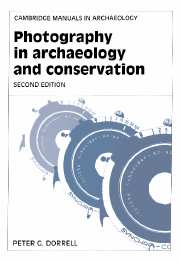Book contents
- Frontmatter
- Contents
- List of illustrations
- Preface
- Preface to the second edition
- Acknowledgements
- 1 The early days of archaeological photography
- 2 Basic principles and practice
- 3 Equipment
- 4 Lighting by flash
- 5 Photographic materials, processing and printing
- 6 Architecture and standing monuments
- 7 Survey photography
- 8 Site photography
- 9 Principles of object photography
- 10 Principles of close-up photography
- 11 Ultra-violet and infra-red photography
- 12 Photographing finds
- 13 Flat copy
- 14 Preparation of material for publication
- 15 The future
- References
- Index
Preface to the second edition
Published online by Cambridge University Press: 23 December 2009
- Frontmatter
- Contents
- List of illustrations
- Preface
- Preface to the second edition
- Acknowledgements
- 1 The early days of archaeological photography
- 2 Basic principles and practice
- 3 Equipment
- 4 Lighting by flash
- 5 Photographic materials, processing and printing
- 6 Architecture and standing monuments
- 7 Survey photography
- 8 Site photography
- 9 Principles of object photography
- 10 Principles of close-up photography
- 11 Ultra-violet and infra-red photography
- 12 Photographing finds
- 13 Flat copy
- 14 Preparation of material for publication
- 15 The future
- References
- Index
Summary
Since the first edition of this book was published in 1989, more and more information has emerged from digs, surveys and conservation programmes, themselves proliferating, while techniques and theories have become more complex if not always more informative. A few more books and papers have appeared on one or other aspect of archaeological photography, e.g. Reiss (1990), and Howell and Blanc (1992), although none that sets out to be comprehensive.
For the future, there are two important challenges, as yet unresolved. One is how the mass of information, visual, textual and mathematical, resulting from excavation and post-excavation work on a site, or from a survey, can be made accessible quickly, coherently, and reasonably economically. At present, information, the results of analyses, and statements and interpretations of underlying theories are apt to arrive piecemeal through interim reports, conference papers, monographs, and articles in different journals, culminating perhaps years or even decades later in a final report which, because of sheer bulk, cannot contain all the accrued information and is thus necessarily selective – a selectivity which in the nature of such things is bound to reflect the opinions and preoccupations of the editor or the director.
The second challenge, equally intractable but in a different way, concerns the new techniques that are rapidly encroaching on the field of silver-based photography. The recording, storage, manipulation and retrieval of images through computer-based systems has already transformed large areas of commercial photography. Undoubtedly within a decade or so these innovations will affect the management of archaeological information, although the form that the changes will take is not yet at all clear.
- Type
- Chapter
- Information
- Publisher: Cambridge University PressPrint publication year: 1994



